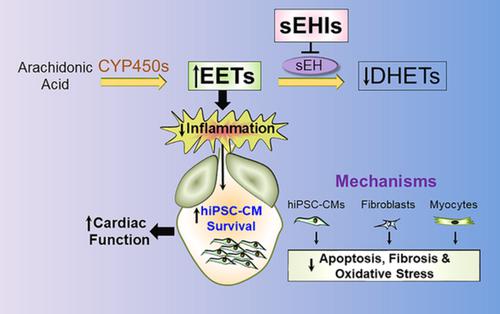当前位置:
X-MOL 学术
›
Stem Cells Transl. Med.
›
论文详情
Our official English website, www.x-mol.net, welcomes your
feedback! (Note: you will need to create a separate account there.)
Suppression of inflammation and fibrosis using soluble epoxide hydrolase inhibitors enhances cardiac stem cell-based therapy.
STEM CELLS Translational Medicine ( IF 5.4 ) Pub Date : 2020-08-13 , DOI: 10.1002/sctm.20-0143 Padmini Sirish 1, 2 , Phung N Thai 1 , Jeong Han Lee 3 , Jun Yang 4 , Xiao-Dong Zhang 1, 2 , Lu Ren 1 , Ning Li 1 , Valeriy Timofeyev 1 , Kin Sing Stephen Lee 4 , Carol E Nader 1 , Douglas J Rowland 5 , Sergey Yechikov 1 , Svetlana Ganaga 6 , Nilas Young 6 , Deborah K Lieu 1 , Ebenezer N Yamoah 3 , Bruce D Hammock 4 , Nipavan Chiamvimonvat 1, 2, 7
STEM CELLS Translational Medicine ( IF 5.4 ) Pub Date : 2020-08-13 , DOI: 10.1002/sctm.20-0143 Padmini Sirish 1, 2 , Phung N Thai 1 , Jeong Han Lee 3 , Jun Yang 4 , Xiao-Dong Zhang 1, 2 , Lu Ren 1 , Ning Li 1 , Valeriy Timofeyev 1 , Kin Sing Stephen Lee 4 , Carol E Nader 1 , Douglas J Rowland 5 , Sergey Yechikov 1 , Svetlana Ganaga 6 , Nilas Young 6 , Deborah K Lieu 1 , Ebenezer N Yamoah 3 , Bruce D Hammock 4 , Nipavan Chiamvimonvat 1, 2, 7
Affiliation

|
Stem cell replacement offers a great potential for cardiac regenerative therapy. However, one of the critical barriers to stem cell therapy is a significant loss of transplanted stem cells from ischemia and inflammation in the host environment. Here, we tested the hypothesis that inhibition of the soluble epoxide hydrolase (sEH) enzyme using sEH inhibitors (sEHIs) to decrease inflammation and fibrosis in the host myocardium may increase the survival of the transplanted human induced pluripotent stem cell derived‐cardiomyocytes (hiPSC‐CMs) in a murine postmyocardial infarction model. A specific sEHI (1‐trifluoromethoxyphenyl‐3‐(1‐propionylpiperidine‐4‐yl)urea [TPPU]) and CRISPR/Cas9 gene editing were used to test the hypothesis. TPPU results in a significant increase in the retention of transplanted cells compared with cell treatment alone. The increase in the retention of hiPSC‐CMs translates into an improvement in the fractional shortening and a decrease in adverse remodeling. Mechanistically, we demonstrate a significant decrease in oxidative stress and apoptosis not only in transplanted hiPSC‐CMs but also in the host environment. CRISPR/Cas9‐mediated gene silencing of the sEH enzyme reduces cleaved caspase‐3 in hiPSC‐CMs challenged with angiotensin II, suggesting that knockdown of the sEH enzyme protects the hiPSC‐CMs from undergoing apoptosis. Our findings demonstrate that suppression of inflammation and fibrosis using an sEHI represents a promising adjuvant to cardiac stem cell‐based therapy. Very little is known regarding the role of this class of compounds in stem cell‐based therapy. There is consequently an enormous opportunity to uncover a potentially powerful class of compounds, which may be used effectively in the clinical setting.
中文翻译:

使用可溶性环氧化物水解酶抑制剂抑制炎症和纤维化增强了基于心脏干细胞的治疗。
干细胞替代为心脏再生治疗提供了巨大的潜力。然而,干细胞治疗的关键障碍之一是宿主环境中的局部缺血和炎症导致移植的干细胞显着丢失。在这里,我们检验了以下假设:使用 sEH 抑制剂 (sEHI) 抑制可溶性环氧化物水解酶 (sEH) 以减少宿主心肌中的炎症和纤维化可能会增加移植的人诱导多能干细胞来源的心肌细胞 (hiPSC-) 的存活率CMs) 在小鼠心肌梗死后模型中。使用特定的 sEHI(1-三氟甲氧基苯基-3-(1-丙酰基哌啶-4-基)脲 [TPPU])和 CRISPR/Cas9 基因编辑来检验该假设。与单独的细胞处理相比,TPPU 导致移植细胞的保留显着增加。hiPSC-CM 保留的增加转化为缩短分数的改善和不利重塑的减少。从机制上讲,我们证明不仅在移植的 hiPSC-CM 中,而且在宿主环境中,氧化应激和细胞凋亡都显着降低。CRISPR/Cas9 介导的 sEH 酶基因沉默减少了受血管紧张素 II 攻击的 hiPSC-CM 中裂解的 caspase-3,表明 sEH 酶的敲低可保护 hiPSC-CM 免于发生细胞凋亡。我们的研究结果表明,使用 sEHI 抑制炎症和纤维化代表了心脏干细胞治疗的一种有前途的辅助手段。关于这类化合物在基于干细胞的治疗中的作用知之甚少。
更新日期:2020-08-13
中文翻译:

使用可溶性环氧化物水解酶抑制剂抑制炎症和纤维化增强了基于心脏干细胞的治疗。
干细胞替代为心脏再生治疗提供了巨大的潜力。然而,干细胞治疗的关键障碍之一是宿主环境中的局部缺血和炎症导致移植的干细胞显着丢失。在这里,我们检验了以下假设:使用 sEH 抑制剂 (sEHI) 抑制可溶性环氧化物水解酶 (sEH) 以减少宿主心肌中的炎症和纤维化可能会增加移植的人诱导多能干细胞来源的心肌细胞 (hiPSC-) 的存活率CMs) 在小鼠心肌梗死后模型中。使用特定的 sEHI(1-三氟甲氧基苯基-3-(1-丙酰基哌啶-4-基)脲 [TPPU])和 CRISPR/Cas9 基因编辑来检验该假设。与单独的细胞处理相比,TPPU 导致移植细胞的保留显着增加。hiPSC-CM 保留的增加转化为缩短分数的改善和不利重塑的减少。从机制上讲,我们证明不仅在移植的 hiPSC-CM 中,而且在宿主环境中,氧化应激和细胞凋亡都显着降低。CRISPR/Cas9 介导的 sEH 酶基因沉默减少了受血管紧张素 II 攻击的 hiPSC-CM 中裂解的 caspase-3,表明 sEH 酶的敲低可保护 hiPSC-CM 免于发生细胞凋亡。我们的研究结果表明,使用 sEHI 抑制炎症和纤维化代表了心脏干细胞治疗的一种有前途的辅助手段。关于这类化合物在基于干细胞的治疗中的作用知之甚少。











































 京公网安备 11010802027423号
京公网安备 11010802027423号